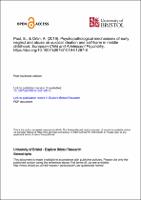Please use this identifier to cite or link to this item:
https://hdl.handle.net/20.500.12202/9639| Title: | Psychopathological mechanisms of early neglect and abuse on suicidal ideation and self-harm in middle childhood. |
| Authors: | Paul, Elise Ortin, Ana 0000-0003-0825-6003 |
| Keywords: | child abuse child neglect Self-injurious behavior Suicidal ideation Longitudinal studies |
| Issue Date: | 2019 |
| Publisher: | Springer-Verlag GmbH Germany, part of Springer Nature 2019 |
| Citation: | Paul, E., & Ortin, A. (2019). Psychopathological mechanisms of early neglect and abuse on suicidal ideation and self-harm in middle childhood. European Child & Adolescent Psychiatry, 28(10), 1311–1319. https://doi.org/10.1007/s00787-019-01287-8 |
| Series/Report no.: | European Child & Adolescent Psychiatry;28(10) |
| Abstract: | Informed by diathesis-stress models of suicide risk, this longitudinal study examines the psychopathological mechanisms through which early maltreatment increases the risk for suicidal ideation and self-harm in middle childhood. The sample included 2958 families from the Fragile Families and Child Wellbeing Study, who participated in interviews at child’s ages of 3 and/or 5, and 9. Via the Child Behavior Checklist, primary caregivers reported on the child’s suicidal ideation and self-harm at age 9 and on clinically elevated depressive/anxious symptoms, aggressive behaviors, attention problems, and comorbid aggression and depressive/anxious symptoms at age 5. Past year neglect and physical/psychological abuse were measured via the Parent–Child Conflict Tactics Scale at age 3. Multivariate structural equation models indicated that early neglect had a significant indirect effect on suicidal ideation via clinically elevated depressive/anxious symptoms (OR = 1.57, 95% CI 1.09–2.25) and comorbid symptomatology (OR = 1.28, 95% CI 1.02–1.62), and on self-harm also via clinically elevated depressive/anxious symptoms (OR = 1.39, 95% CI 1.04–1.84) and comorbid symptomatology (OR = 1.20, 95% CI 1.01–1.43). Early physical/psychological abuse had a significant indirect effect on self-harm via clinically elevated attention problems (OR = 1.09, 95% CI 1.01–1.21). Unique developmental pathways for suicidal ideation and self-harm emerged among children exposed to abuse or neglect. For those exposed to early neglect, interventions should target depressive/anxious symptoms, especially when comorbid with aggression, to prevent suicidal ideation and self-harm. For children exposed to early physical/psychological abuse, problems with attention and impulsivity may be targets for reducing the risk for self-harm |
| Description: | Scholarly article / Open access |
| URI: | https://hdl.handle.net/20.500.12202/9639 |
| ISSN: | 1018-8827 1435-165X |
| Appears in Collections: | Ferkauf Graduate School of Psychology: Faculty Publications |
Files in This Item:
| File | Description | Size | Format | |
|---|---|---|---|---|
| Paul_and_Ortin_2019-OA Psychopathological.pdf | 388.94 kB | Adobe PDF |  View/Open |
This item is licensed under a Creative Commons License

